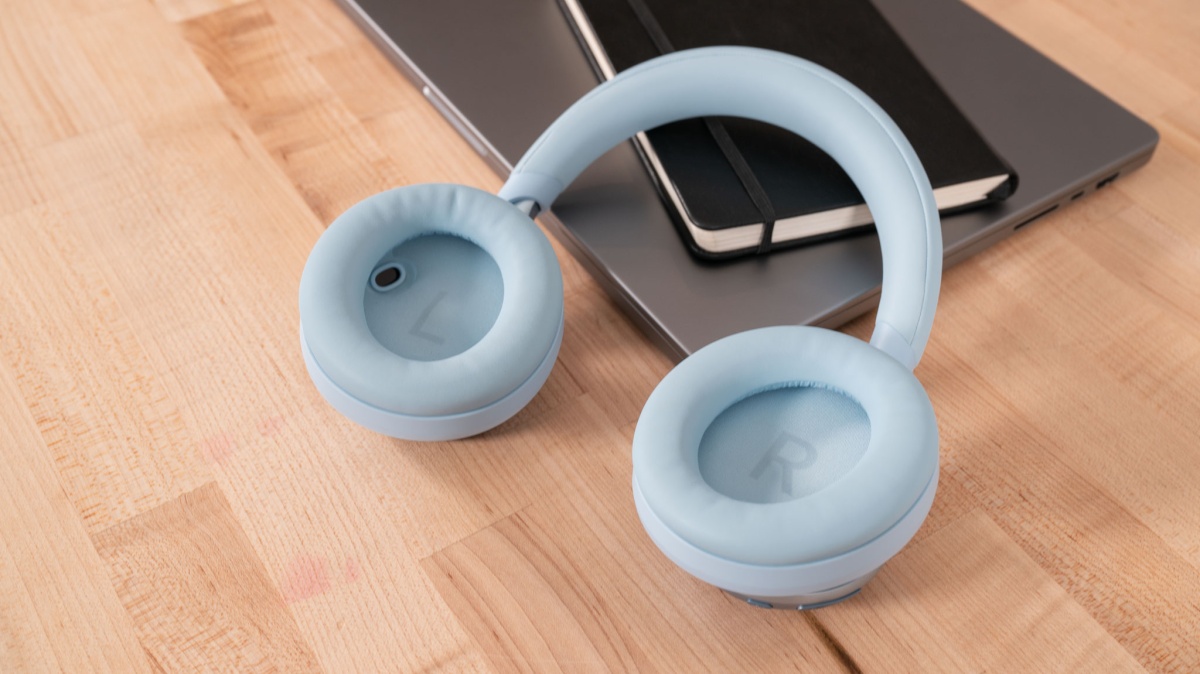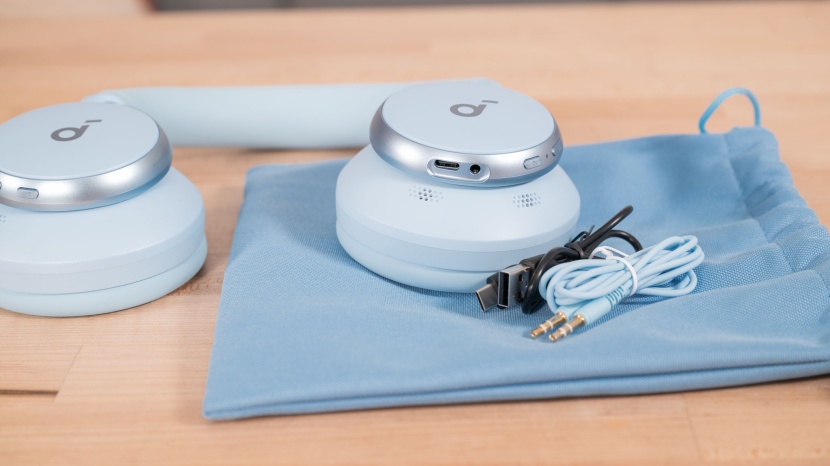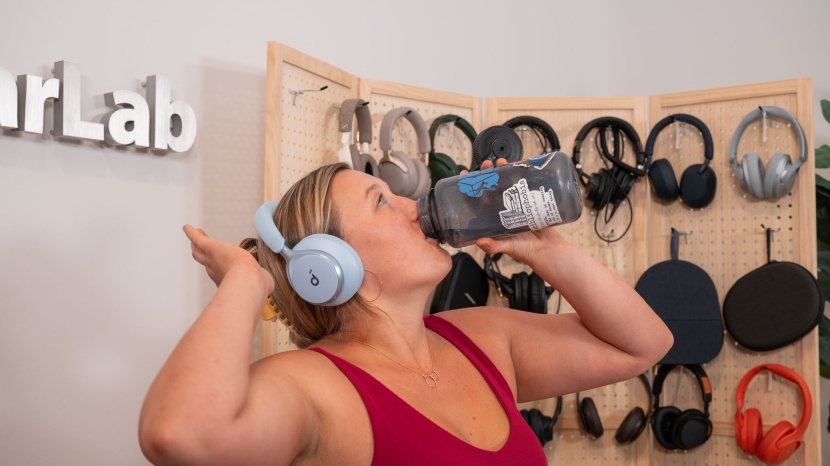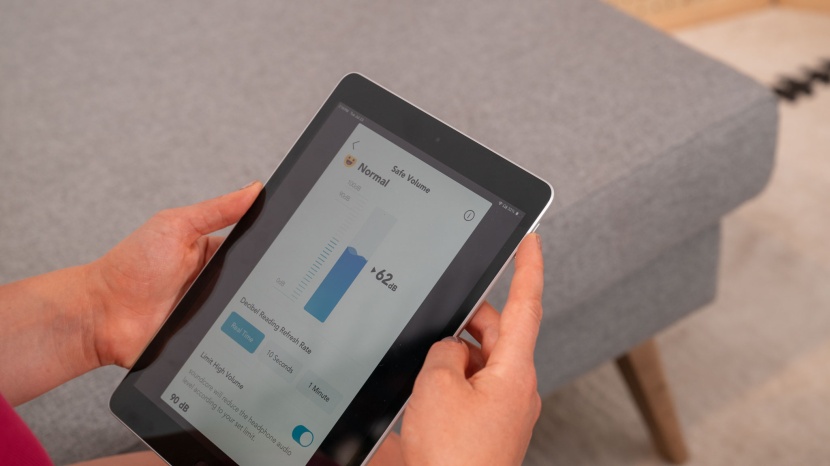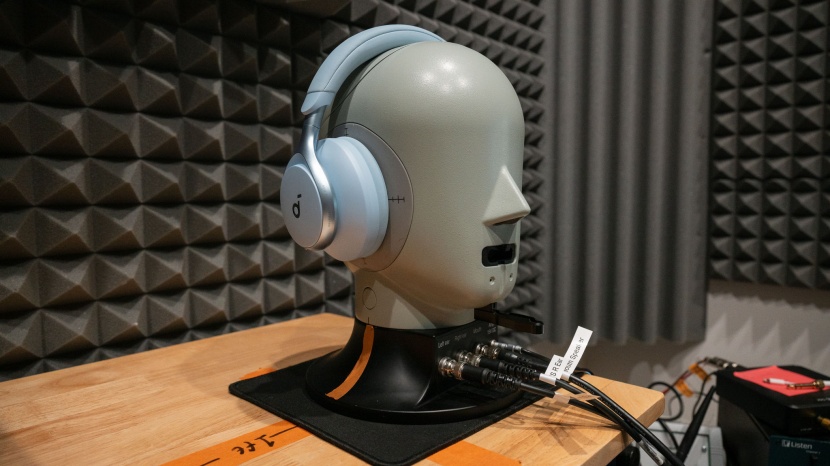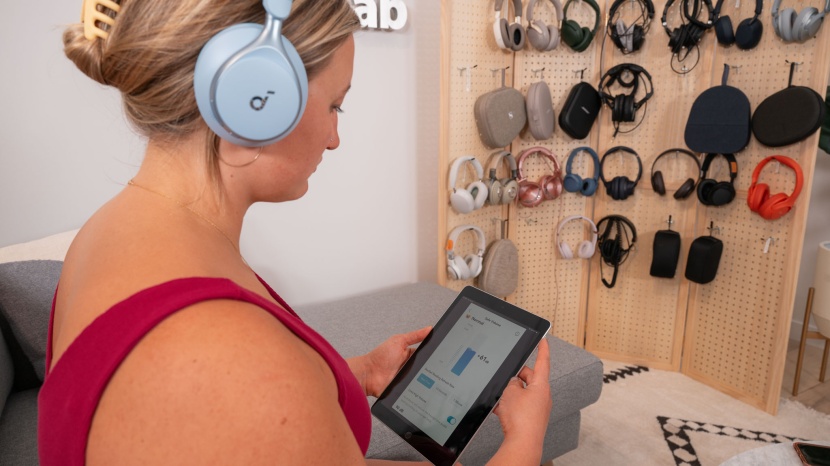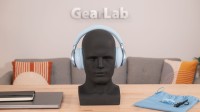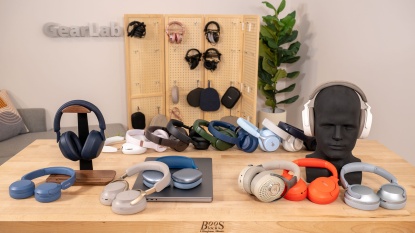
Our Verdict
Our Analysis and Test Results
Our Soundcore Space One Headphones Experience
The Space One feels cheaper than we would have suspected. While a budget set, they didn't match the same look and feel of similarly priced options. They come with a velvet-type carry bag that feels like an afterthought, a charging cord, and an audio cable.
These headphones are comfortable initially, thanks to pillowy earcups and a softer fabric. However, the clamping force is somewhat inadequate, and the round earcup shape may not fit everyone, as well as the fabric becoming sweaty over time. We also didn't think they were the best for wearing glasses, which could be a result of the larger size of the cups.
They offer decent stability, enabling use during light activities like stretching, walking, and yoga; though, we wouldn't recommend them for heavier activities like the gym or a run.
The saving grace of Space One is that the overall user interface is decent. They have tactile button controls that are easy to memorize, and their EQ is readily customizable.
The shorter battery life is certainly long enough for one to two days of long-wearing sessions. However, when we forgot to charge them, we ended up with nothing and wished they had a longer battery life. While they aren't the worst in the group, more is always better, and we wish they matched their claimed battery life of 40 hours.
Using these headphones while making phone calls is less than ideal, and we ended up disconnecting them and using the phone itself when calls were necessary. They perform well in quieter environments where background sounds are minimal, but any ambient noise while talking results in clipped words, muffled sounds, and a strange “squeezing” of the words.
Sound Quality
We were unimpressed with the Soundcore Space One's sound profile. The bass boom tends to overpower every track, whether it has a lot of bass or not. They are quieter than expected, and we had to turn them up to get the most out of them. While the overall sound isn't downright awful, it is disappointing compared to other contenders, regardless of gain level. On the upside, we didn't notice much distortion, even at higher volumes, but the overpowering bass is droning and exhausting.
While the low-end is undeniably powerful, it can often feel excessive. This enhanced bass can sound fun and exciting in some tracks, but in most, it dominates your attention. Songs like “Check the Rhime” by A Tribe Called Quest showcase deep, booming bass in a fun way. The drums really take center stage at the 1:56 mark, and these headphones are well-equipped to deliver, providing a ton of punch and power that makes it nearly impossible not to move your body along as you listen. This is where the elevated bass presence works in the headphones' favor. More often than not, that's not the case. If you're into genres like hip-hop and EDM, this might suit your taste. However, listeners of more balanced genres will likely find the bass too dominant, which can reduce the clarity and impact of other frequencies.
The midrange frequencies leave much to be desired. Tracks like “None of Your Concern” by Jhene Aiko feel hollow, lacking the depth and texture that well-produced mids can provide. Dull is a good way to describe them; human voices, which are mid-heavy, feel blunted and colorless. Furthermore, the subpar mids often feel overshadowed by the bloated bass, resulting in an unbalanced sound. This is a letdown for listeners who appreciate strong vocals and instruments in this frequency range.
The treble performance on these headphones is pretty abysmal. The low-end treble blurs into the already muddy upper mids, and vocals feel awkwardly pushed around by these headphones' inability to handle them accurately. Songs like “Mushaboom” by Feist lose their brightness and clarity, as the high-end feels disappointingly muted. While the treble never becomes shrill or harsh, it lacks the detail and sparkle that bring music to life, especially in genres with high-pitched instruments or vocals. What's worse is that these headphones elevate this poor treble performance nearly as high as the booming bass, leading to a nauseating push and pull of the listener's attention toward poor-quality audio on both ends of the spectrum.
Ultimately, these headphones are heavily focused on bloated bass, making them unsuitable for those seeking a more balanced and detailed listening experience. The lack of clarity in the mids and treble further emphasizes this imbalance.
The Space One's frequency response showed that they follow our GearLab House Curve somewhat in the bass and midrange, but the treble is higher than we prefer. Our curve analysis indicates that they produce noise at the frequencies we'd expect, consistent with our real-world impressions.
The takeaway is that the bass is heavily emphasized. At the same time, the dull mids are muted, and overpowering highs struggle to match the clarity and balance we seek. If these suit anyone (which we don't think they would), they'd be listeners who prioritize boomy bass over balance and clarity across the frequency range.
Soundstage
The Space One provides a moderate sense of space, though it doesn't deliver the depth and width we'd expect.
Songs like “Nightwind” by Lonas showcase some degree of instrument separation, but the sound mostly feels like it's coming from within the headphones, without much room for the music to breathe. They don't provide an expansive or immersive experience.
Comfort and Fit
These are comfortable enough for most users to wear for about 8 hours. They have a lightweight design (263 grams), a low clamping force, and spacious ear cups (60mm by 48mm). Our smaller-headed testers almost found these too spacious. Listeners with glasses may notice some pressure points due to the larger ear cups, which may take some time to get used to.
Noise Cancellation
The Space One performed decently for noise cancellation. While not top-of-the-line, it performed adequately, especially considering the price point. We tested their ANC and passive noise cancellation by playing controlled environmental sounds, recording and measuring any noise that seeped past the earcups.
These do an okay job of passively blocking background noise (with ANC off). Treble (2kHz+) and mids (500Hz to 2kHz) are subdued, and high-pitched clattering, like keyboards and far-away conversations, are diminished. However, bass frequencies (0hz to 500hz) get readily past the headphones, making them vulnerable to thumps and low-pitched rumbles.
With ANC turned on, bass frequency abatement is significantly increased, with treble and mids also experiencing improved reduction. These improvements are less noticeable in the real world, with nearby conversations and various office noises occasionally bleeding through. While usable in noisy environments, they won't create a bubble of silence found in premium competitors.
App and Controls
While these have an adjustable EQ, they are almost overwhelmingly customizable, and none of the available presets improve the sound quality. The Soundcore app offers premium features, such as HearId, which tests the wearer's hearing and creates a custom sound profile. There are also settings for volume limitation and activating wind noise reduction.
Connectivity
While these have multipoint connectivity (pairing two Bluetooth devices simultaneously), the setup process feels clunky, forcing disconnection and reconnection to the first device. They are much easier to set up on Android.
Battery
Soundcore claims the Space One has up to 40 hours of battery life with ANC on. However, we never achieved a performance over 26 hours, which is disappointing.
Since they offer better comfort, it would have been nice to see improved battery life compared to other contenders, resulting in fewer weekly charges.
Call Quality
The Space One had some of the worst call quality. Whether in a silent room or on the subway, we experienced troubles. All of the voices have a strange echo effect, even at baseline. When background noise is added, it becomes noticeable that computational muting is occurring, making voices sound unnatural and reverberant.
During the subway noise stress test, this effect was even more disorienting, with low-pitched voices cutting in and out, and high-pitched voices sounding as if every word was being squeezed.
If call quality is your priority, we don't recommend these. It would be more effective to speak over the phone itself.
| Awards | |
|---|---|
| Price | $100 List Check Price at Amazon |
Overall Score  |
|
| Star Rating | |
| Bottom Line | They are chock-full of features, but their sound profile is not enjoyable |
| Pros | Ccustomizable EQ, Android-friendly |
| Cons | Poor sound, poor calls |
| Rating Categories | Soundcore Space One |
| Sound Quality (35%) | |
| Comfort (25%) | |
| Noise Cancellation (20%) | |
| App & Controls (10%) | |
| Call Quality (10%) | |
| Specifications | Soundcore Space One |
| Comfortable Listening Hours | 6.0 hrs |
| Claimed Battery Life | 40 hrs |
| Wearing Detection | Yes |
| Multipoint | Yes |
| Measured Weight | 263 g |
| Measured Maximum Connectivity Distance | 191 ft |
| Measured Ear Cup Size | 60 mm H x 48 mm W |
| EQ Customization | Yes |
| Driver Size | 40 mm |
| Passive Playback | Yes |
| Spatial Audio | No |
| Active Noise Cancelling | Yes |
| Transparent Mode | Yes |
| Connectivity Options | SBC, AAC, LDAC |
| Carrying Case | Bag |
| Included Cords | -USB-A to USB-C cable -3.5 mm to 3.5 mm audio cable |


